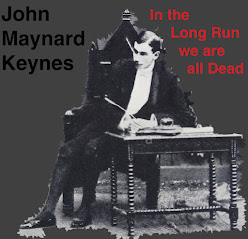First, let me list some quotes from the (SE) article and John Maynard Keynes (JMK):
- “Our power of prediction is so slight, our knowledge of remote consequences so uncertain that it is seldom wise to sacrifice a present benefit for a doubtful advantage in the future.” (JMK)
- ...it was “not sufficient that the state of affair which we seek to promote should be better than the state which preceded it; it must be sufficiently better to make up for the evils of transition.” (JMK)
- ...in Keynes’s hands a critique of the equilibrium analysis offered by neoclassical economics. Indeed, Keynes explicitly extended this theoretical critique of equilibrium theories into a political critique of austerity measures derived from them. (SE)
- ...orthodox economists ... demanded interwar austerity based on the long-run extrapolations of neoclassical economics. (SE)
- ...it was only in the neoclassical long run that the economy was assumed to have finally reached its “natural” state of equilibrium. (SE)
- ...“the long run” of neoclassical economics lacked temporal specification. No one could know whether it would arrive in twelve months or seven years. (SE)
- [Keynes] ... preference for Malthus’s economic theorizing from “the real world” over Ricardo’s more abstract starting points...Since the future of mankind was shaped by the most irregular movements, to draw too straight a line from the present to the future was a sure way to mislead oneself. (SE)
- The ...“long run” of neoclassical economics essentially evacuated politics from the future. (SE)
- Rejecting the naturalized long run thus implied for Keynes at the same time a need to articulate broader future possibilities. This is evident not least in Keynes’s own interest in alternative imagined futures, most famously in his essay on “Economic Possibilities for our Grandchildren” (1930) (SE)
- Postwar Keynesianism’s commitment to perpetual growth coupled with a deep intellectual investment in modernization theory can indeed be read as offering a linear conception of growth as progress that served to stabilize a deficient present. (SE)
- The mode of social change that Keynes embraced in response to this challenge was a notion of open experimentation. (SE)
- Here as elsewhere, Keynes consciously placed himself outside of interwar debates over planning by offering alternative conceptions of decentralized or independent bodies of administration that would be essential for crafting new tools of indirect economic steering—including what we have come to call macroeconomic policy. (SE)
- ...there is no such thing as “the future” but instead only ever a proliferation of multiple yet unformed possibilities, Keynes flagged the centrality of the politics of such future time. (SE)
- The "Long Run" line first appeared in A Tract on Monetary Reform, published in December 1923. More specifically, it appeared in the third chapter on “The Theory of Money and of the Foreign Exchanges” and came in the context of a technical discussion of the quantity theory. (SE)
- Speculative visions of the future are thus performative in the sense that they feed back into how people act in the present. As Keynes argued in the seminal twelfth chapter of the General Theory (1936), our estimates of even the comparably near future are so inescapably obscured by uncertainty that they cannot form any reliable, let alone calculable basis for our actions in the present. And yet we have to act. (SE)
In my blog Facts, Fictions and Forecasts, I present forecasts based (1) on a technique used by the Atlanta Federal Reserve (here) and (2) on an approach to multi-model forecasts used by US National Oceanic and Atmospheric Administration's (NOAA) for hurricane forecasting and the IPCC Climate Change Emission Scenarios. You can see an example applied to the US here and here. For me, these are the kinds of forecasts Keynes was talking about: conditional, probabilistic, and based on historical data rather than theory. Systems Theory helps me develop and interpret the models and resulting forecasts. No assumptions about equilibrium or stability are imposed on the models.
The recommendation for experimentation is interesting. I started my professional career as a program evaluator/statistician with the Nixon-era Wisconsin Alcohol Safety Action Program ASAP in the early 1970s.
The Wisconsin program had a mixed record of success with Alcoholism programs and with the overall project. As I remember the project conclusions, the reduction of speed on Wisconsin highways to 55 mph (largely the result of the 1973-74 Arab Oil Crisis) had more effect on alcohol related deaths than the ASAP programs. The takeaway for me, at the time, was that natural experiments (such as the 1973-74 Arab Oil Crisis) had more impact than government programs. This lead me to Systems Theory, History and to Counterfactual Thinking (what if things had been done differently).
Now, at the end of my career, I keep writing that I will not be alive to see the future of the US Economy, for example, or any other country's future that I write about. I can only bring my brick to the wall and hope that the methodology is useful at some point in the future.




No comments:
Post a Comment